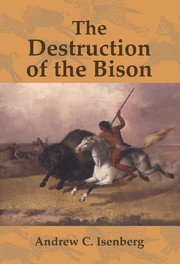6 - The Returns of the Bison
Published online by Cambridge University Press: 05 August 2012
Summary
The itinerant artist George Catlin reflected, while touring the Missouri River valley in 1832, that the bison was “so rapidly wasting from the world, that its species must soon be extinguished.” To save the herds, Catlin recommended that the federal government create “a nation's Park” in the grasslands. He imagined that both the bison and the Indians who hunted them “might in future be seen (by some great protecting policy of government) preserved in their pristine beauty and wildness, in a magnificent park.” For the next forty years, however, the United States government declined to pursue Catlin's vision. Rather, federal authorities welcomed the diminution of the herds because it forced famished Indians of the western plains to submit to the reservation system. Yellowstone, the United States' first national park, was located in the scenic Mountain West, far from the bison's range in the shortgrass plains. In the late nineteenth century, however, Yellowstone National Park, established in 1872, was the only public refuge for the bison apart from city zoos. By the 1880s, a few hundred bison – the largest group of survivors in the United States – had found refuge there from commercial hunters, drought, and the destruction of grazing lands by farmers and livestock.
This remnant herd and other scattered survivors might eventually have perished as well had it not been for the efforts of a handful of Americans and Canadians.
- Type
- Chapter
- Information
- The Destruction of the BisonAn Environmental History, 1750–1920, pp. 164 - 192Publisher: Cambridge University PressPrint publication year: 2000



